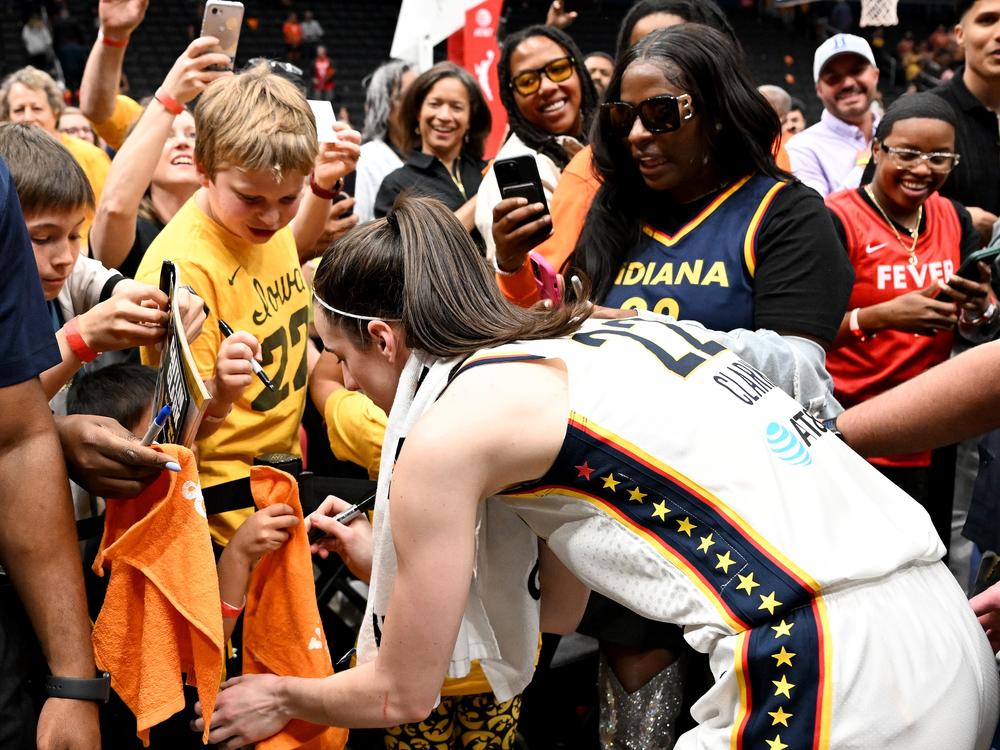Section Branding
Header Content
The WNBA, capturing excitement around Caitlin Clark, boasts more viewers than ever
Primary Content
More than 400,000 people attended WNBA games in the month of May, and more than half of them were sellouts, the league announced Monday — making it the highest-attended month for the WNBA in well over two decades.
Viewership, too, is up across all of the league's broadcast and streaming platforms and among a variety of demographics, including young viewers, the WNBA said.
The numbers, released by the league, show that WNBA has been able to capitalize on the extraordinary burst of interest in women's basketball that had emerged in recent years around college basketball and especially the former University of Iowa star Caitlin Clark.
Clark, now 22, was drafted first overall by the Indiana Fever in April. Since then, the Fever — which drew about 81,000 fans across its entire 2023 season — surpassed that total in its first five home games of the season.
Clark also drives attendance at away games. On Friday, in Washington, D.C., more than 20,300 people came to Capital One Arena to watch the Fever take on the Washington Mystics. No two WNBA teams have more losses between them, but still the attendance marked the WNBA's most-attended game since 2007, according to Across The Timeline.
The Mystics' normal home arena seats around 4,100 people. But the interest in the team's game against the Fever was so high that officials moved the game to Capital One to accommodate the bigger crowd.
Among the new fans at the game Friday were Jason Smith and his 9-year-old daughter, Autumn. Neither had ever watched the WNBA before this season, he said, but Autumn's interest in Clark — especially "her three-point shots and her really good passes to people," his daughter explained — had brought them to their first-ever WNBA game.
"We've been following her for the last two years, and the opportunity came up to see her, so the two of us headed into the city," Smith said. Now, he and his daughter are following four teams, he said: Clark's Fever, their local Mystics, the Chicago Sky and the reigning champions Las Vegas Aces.
Other teams have seen their viewership and attendance increase in part due to their own rookies. Alongside Clark, the first-year pros Angel Reese of the Chicago Sky and Cameron Brink of the Los Angeles Sparks ranked in the top five for jersey sales in the first week of the season, the WNBA said.
Overall, sales of WNBA merchandise are up 236% year-over-year, the league reported.
It has not been since the league was brand new in the late 1990s that there was such a high level of interest in professional women's basketball in the U.S.
The WNBA's first season took place in 1997, less than a year after the U.S. women's national team won the gold medal at the 1996 Summer Olympics; the U.S. hasn't lost a match at the Olympics since. (Clark recently confirmed reports that she has been left off of the Olympic team at next month's Olympics in Paris, news that prompted heated debate online and in the media about whether she should have been included.)
The elevated attendance and ratings are expected to continue through the season, which will end in October.
"I just love the fact that women are finally getting recognition in this sport," said Elizabeth Lee, who came to the Mystics-Fever game with her husband and two school-age children.
Though she and her family have long been WNBA fans, they welcome the new swell of support, Lee said. "The players play so hard, and they work so hard every season. To finally get the recognition they deserve is really exciting," she said.

